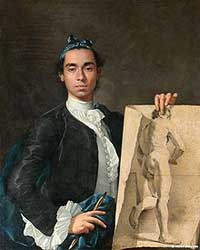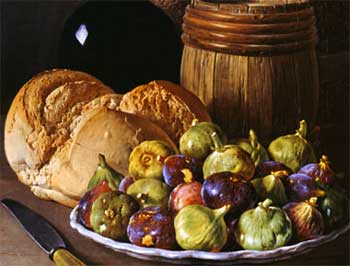
Accidental Master of the Commonplace
Luis Meléndez’s still lifes at the National Gallery
By Maureen Mullarkey
STILL LIFE BLOOMED LATE AMONG ART HISTORICAL CATEGORIES. Depictions of prosaic objects have been with us since antiquity but rarely for their own sake. They served votive purposes or figure compositions submissive to higher themes. Food stuffs and tableware entered as props for a Last Supper, an edifying banquet, or some festal spread catered by the gods and laced with allegory. Not until the seventeenth century could the naked facts of a herring, a wine bottle and a scatter of onions be presented without apology.
 |
| Luis Meléndez, Self Portrait, 1747 |
What we moderns take for granted as still life lacked even a term for itself until the mid-1600s when stilleven, a matter-of-fact descriptive, started showing up in Dutch inventories. It took another hundred years before the French coined nature morte, a chilly classifier. Spaniards settled upon the homely bodegón, a nod to edible things and the abiding primacy of the kitchen.
Luis Meléndez (1715-1780), one of Spain’s greatest still life painters, was the accidental practitioner of a genre just beginning to speak its name. His bodegones, not well known in the United States, are debuting in a traveling exhibition that has begun at the National Gallery of Art. On view are some 31 breathtaking transfigurations of the mundane, each one a tribute to the splendor of the overlooked.
Luis’s training began in his father’s studio. The elder Meléndez, a distinguished painter in the household of Philip V, produced miniature portraits of the royal family for distribution as diplomatic gifts. In addition, he designed illuminated certificates of nobility. (Then, as now, papers mattered.) These were as elaborate as full-sized oil paintings and often combined with religious imagery. Command of the human figure, the capstone of artistic training, was crucial.
Luis was among the first to enroll in Philip’s fledgling royal academy. Expectations were high for the young artist admitted with the highest marks. Luis’ confidence declares itself in the masterful 1746 self-portrait that prefaces the exhibition. Painted in the year of his admittance to the inaugural class, it presents him as a self-possessed caballero. Elegantly dressed, he carries the attributes of a student: a chalk holder (still in use today) and a folio sheet bearing a virtuoso oil rendering of a chalk drawing of a male nude. This drawing-within-the-portrait restates his aptitude for the figure and affirms an equal facility for trompe l’oeil, still life’s ancient traveling partner.
His early prospects, intimately aligned with his father’s, ran aground on missteps, personality clashes, and plain bad luck. The biographical record, spotty as it is, tells of a proud, ambitious artist gifted in everything but the temperament for advancement within a centralized patronage system. His father, the academy’s director of painting, seems to have been a prickly model. Both father and son were soon expelled from the institution, crippling young Meléndez’s opportunities for the major figurative projects his talent promised.
Unbowed, the artist reinvented himself as a still life painter. And what a stunning job he made of it. His singular mastery of a minor genre became the vehicle for his eventual breakthrough into court patronage under the Prince of Asturias, later Charles IV. In 1770, the prince invited Meléndez to produce an encyclopedic collection of paintings of seasonal foods produced on Spanish soil — a natural history of agricultural Spain.
Meléndez combined rigorous structural design, thematic wit, and a quiet yielding to the facts of a meal. For all their ecstatic detail and horticultural veracity, these works are more than close-range quotations from the world. They are also exquisite enactments of a compelling artistic conscience. Meléndez’s orchestrations of kitchen produce, executed in loving fidelity to naturalist concerns, are woven with cues that lend resonance to verisimilitude.
At quick glance, Still Life with Game (c. 1770) is a straightforward tabletop piece. Two dead pigeons lie in front of the copper kettle that waits to braise them. But the turn of their bodies, entwined with unnatural delicacy, telegraphs extra-culinary intention. The downy head of one bird rests sweetly, as if in caress, within the soft hollow of its companion’s upturned neck. The staging suggests the death embrace of a tragic couple. (Meléndez’s audience would have known the legendary doomed lovers of Teruel, Spain’s own Tristan and Iseult.) To emphasize the poignance, two spice packets lie chastely side by side in the foreground, each twisted at the ends to suggest heads and feet. Or tail feathers. One lifeless pairing echoes another.
 |
| Luis Melendez, Still Life with Figs and Bread, c. 1760s |
On one level, Still Life with Fish, Bread, and a Knife (c. 1772) is a plainspoken inventory of the ingredients for a meatless Lenten meal. But in the land of Cervantes, luxuriantly devoted to soldiering, the position of that shining sea bream insinuates a fallen guerrero. Propped improbably on its tail, atop a knife and slumped against an overturned soup pot, the fish — mailed in lustrous scales — impersonates a wounded knight. The knife handle is visible on the fish’s left; the blade shows on the right, a charade of impalement. A pink fin, dark red in shadow, mimics a bloody gash. The ensemble is a teasing blend of cultural emblem with genuine feeling for the thing-in-itself.
The vanitas theme threads through the exhibition just as it does through the history of still life. Meléndez’s work is a theater of delight in organic form — that heart-stopping cauliflower! a bliss of figs — but the shadow of memento mori passes over it nonetheless. References to mortality peek from behind the veil of natural description. What is that shattered watermelon, glistening red flesh spilling onto the ground of a darkling landscape, if not an intimation of death on the run? Elsewhere, decay is not far off in bruised, overripe apples and pears. The pity of maturation.
Sly tension between depiction and suggestion exists in several end-of-dinner motifs that include narrow boxes of sweets. Pictorially, these rectangular forms register lighting effects and provide counterpoint to rounded volumes. They also function metaphorically. Made of rough scrap wood, they resemble stacks of coffins. Visible at the corner of one is a bit of wrapper. A hint of winding cloth? Instead of the customary skull, worm, or hourglass, Meléndez features — in miniature — the plain pine box that beckons us all.
Viewed from the narrow angle of our own era, Meléndez exhibits certain pictorial concerns similar to modernist ones. Here are those spatial ambiguities that our own eyes are conditioned to admire. [Is there really room for that much bulk on such a narrow shelf?] Eager to show Meléndez in a modern light, the exhibition catalogue flourishes a Morandi still life for comparison. Yet it is precisely Meléndez’s distance from modernity that is so arresting. His sensibility thrived on the continuity of cultural memory. He worked, as did his contemporaries, in anticipation of discernible meaning and trustful of its reception. His produce medleys are loyal to the seasons; and his unifying theme of the four elements (earth, air, fire, water) assumes an audience whose cultural field extended back, however fitfully, to Empedocles.
Meléndez’s repertory of enduring forms — the spoon, jar, bowl, and beaker, together with pantry stuffs — are still with us, triumphant over generational time. In the rhythms and transmitted rituals of meal preparation lies the divide between brute existence and civilized life. So much depends on fresh cauliflower and a loaf of bread.




Exhibition continues to the Los Angeles County Museum of Art, September 27, 2009 - January 3, 2010, and to the Museum of Fine Arts, Boston, February 1 - May 8, 2010.
This essay appeared first in The Weekly Standard, July 17, 2009.
Copyright 2009, Maureen Mullarkey







